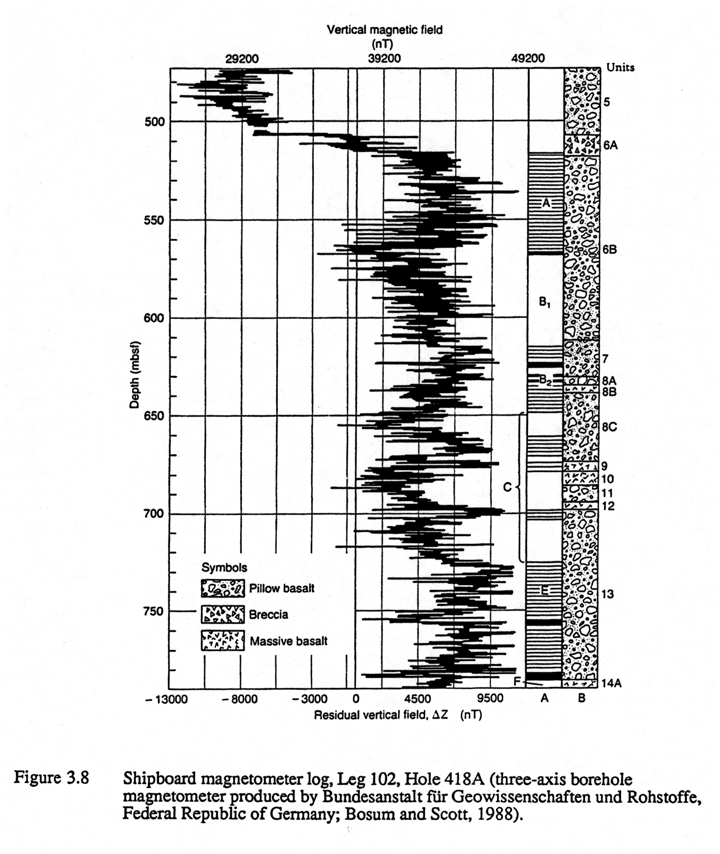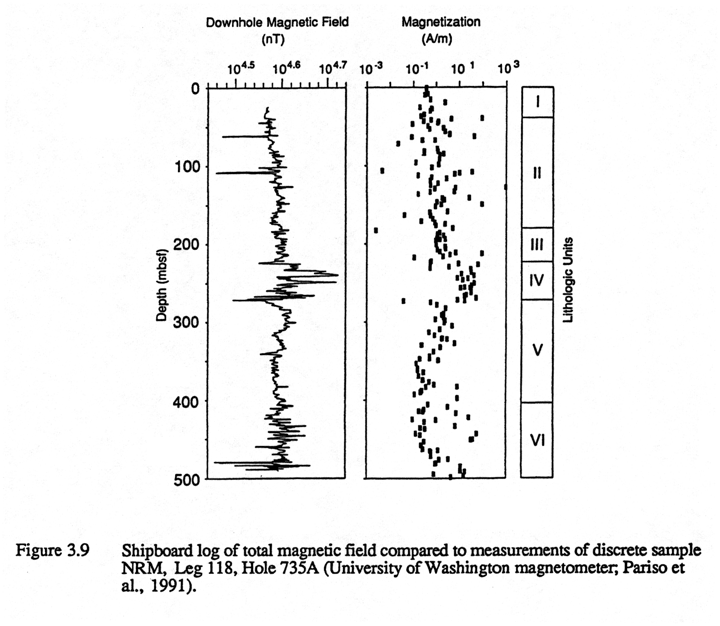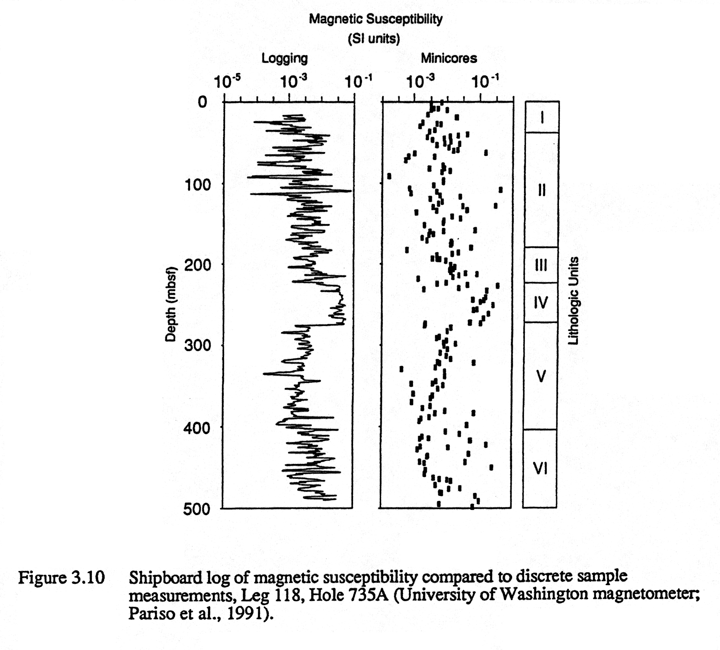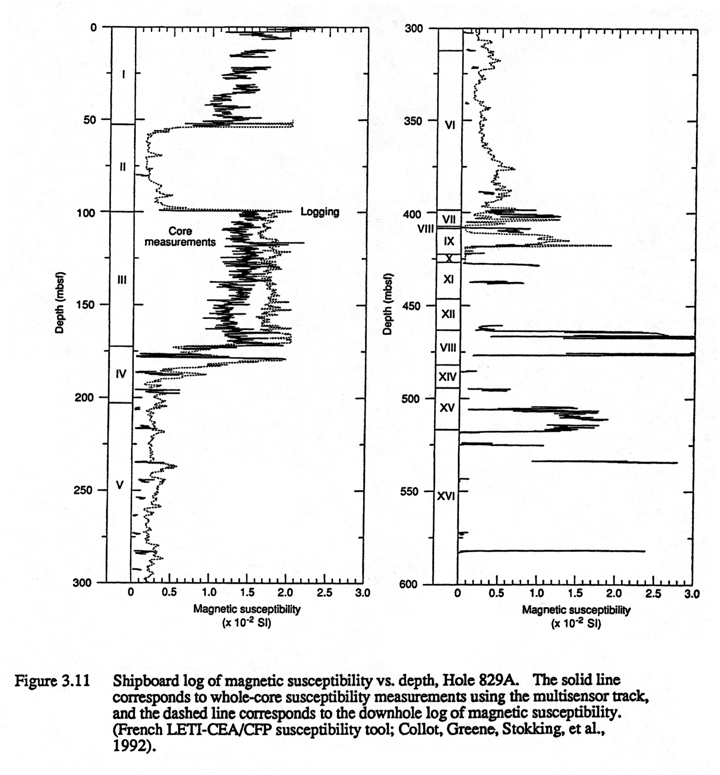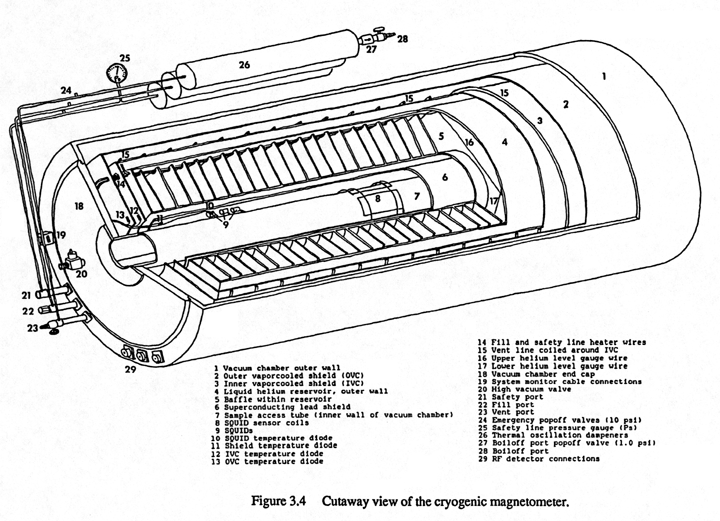
The shipboard paleomagnetics laboratory is illustrated in Figures 3.1, 3.2, and 3.3. Brief descriptions of the equipment available in the shipboard paleomagnetics laboratory are provided below. Appendix 4 lists the equipment manuals, provided by manufacturers, that are available in the laboratory. This section is not intended to replace these equipment manuals or training in operation of equipment provided to shipboard scientists by the Marine Specialists assigned to the paleomagnetics laboratory.
The 2G 760-R superconducting rock (cryogenic) magnetometer (Figs. 3.1,
3.2, and 3.4) is used primarily for continuous remanence measurements on
archive halves of cores. AF coils arranged on-axis with the magnetometer and
set within the magnetometer's mu-metal shielding allow uniform
demagnetization of the cores, so that both NRM and demagnetized remanences
can be measured. (Whole cores can be run providing that their diameters are
first checked to assure that no bulges are present; otherwise, cores may
become stuck.) The cryogenic magnetometer may also be used to measure and
demagnetize discrete samples. Measurements on the cryogenic magnetometer are
initially made in units of magnetic flux, phi0; calibration to magnetic
moment (mA·m2) depends on the geometry of the coils, and so varies from axis
to axis. Prior to Leg 121, calibration factors were x-axis, 1 phi0 = 1.740 x
10-4 mA·m2; y-axis, 1 phi0 = 1.646 x 10-4 mA·m2; z-axis, 1 phi0 =
1.215 x 10-4 mA·m2. Since Leg 121, the calibrations have been x-axis, 1 phi0
= 1.77 x 10-4 mA·m2; y-axis, 1 phi0 = 1.57 x 10-4 mA·m2; z-axis, 1 phi0 =
1.32 x 10-4 mA·m2. After processing, measurements are reported in units of
mA/m. Raw x, y, and z files are not routinely saved. The theoretical noise
level of the superconducting quantum interference device (SQUID) sensors is 3
x 10-5 phi0. The noise level observed on the JOIDES Resolution
depends, in part, on the amount of roll of the ship. Measurements of the
empty sample boat indicate a magnetic moment (within the measuring region,
which is equivalent to a volume of about 150 cm3 when a full
archive half is being measured) on the order of 10-6 mA·m2
(10-6 emu). The strongest samples which have been measured with
the cryogenic magnetometer are half cores of basalt with intensities up to
8000 mA/m.

The results produced by the shipboard cryogenic magnetometer have been
compared with those produced by the shipboard spinner magnetometer and with
those obtained using shore-based equipment. Good correlation has been
demonstrated, as illustrated in Figure 3.5.
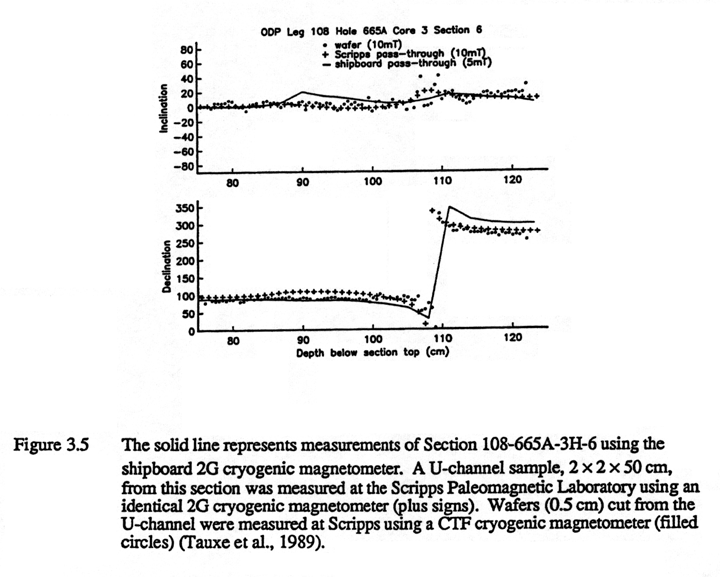
The cryogenic magnetometer lies inside three concentric mu-metal cylinders. Its AF coil assembly is also contained within these shields. Prior to Leg 123, a system was installed that increased degaussing potential from 9 to 25 mT. Prior to Leg 132, the axis control boxes were upgraded to improve flux-jump counting capabilities. A superconducting lead shield surrounds the sensing region and maintains an absolutely stable field within that region.
The paleomagnetics Marine Specialist monitors the vital signs" of the instrument daily to ensure that temperatures remain constant within the instrument and to check helium boil-off. The cryocooler adsorber is changed annually.
The Molspin Minispin spinner magnetometer is a basic field unit interfaced with a microcomputer for control and data acquisition. The software driving the Minispin executes spin sequences and calculates declination, inclination, and intensity in mA/m corrected for the volume of the sample. A series of measurements is made on each sample as it is run through a demagnetization sequence. Ordinarily, six separate spin orientations are required to produce an accurate measurement. In general, the processing rate will vary with the NRM intensity and response to demagnetization of the samples from a particular lithologic unit.
The Minispin can measure both rock and sediment samples up to 2.54 cm (1 in.) cubed in size. According to the manual, the noise level varies from 0.2 mA/m (short spin) to 0.1 mA/m (long spin). The minimum measurable intensity is on the order of 0.1 mA/m, and the maximum is on the order of 2500 mA/m. Parameters that can be specified by shipboard paleomagnetists include short (24 spin) versus long (120 spin) integration time and sensitivity range.
A Schonstedt Alternating Field Demagnetizer, Model GSD-1, is available for demagnetization of discrete samples of rock or sediment (Fig. 3.3). The user can select a range of peak alternating fields from 0 to 100 mT .
A Schonstedt Thermal Demagnetizer, Model TSD-1, is used for thermal demagnetization of dry rock samples over a temperature range of 0°C to 800°C. The instrument contains magnetically shielded heating and cooling chambers.
An ASC Impulse Magnetizer, Model IM-10, is available for studies of the acquisition of isothermal remanence (IRM) and anisotropy of IRM (Fig. 3.3). The unit was designed to provide short-term fields from 0.02 to 1.0 Tesla (T), but is capable of generating fields up to about 1.3 T. The sample holder provided with the instrument can hold 1-in. sample cubes and minicores 1 in. in diameter in several different orientations. In order to generate the impulse field, a bank of capacitors is charged to the voltage required to produce the desired field. The capacitors are quickly discharged into the coil surrounding the sample when the trigger button is pressed. NOTE: The electrical currents involved are very high. In case of malfunction, the unit should be opened only by ASC employees or ODP electronics specialists. The front panel contains a power switch, the trigger switch, the voltage-adjustment knob, the charging voltage meter, and a trim switch. The user selects the charging voltage using the voltage-adjustment knob; the voltage to which the capacitor bank is charged is displayed on the charging voltage meter. The trigger discharges the capacitor bank into the coil. Depressing the trim button slowly discharges the capacitor bank, permitting the user to decrease the charging voltage without triggering the capacitors to discharge. Table 3.1 lists calibration data for ODP serial number 01971 as of 18 August 1992.
The DTECH Partial Anhysteretic Remanent Magnetizer (PARM) can produce a direct current (DC) magnetic field up to 1 mT (10 gauss) (Fig. 3.3). The system comprises a control unit, dual coils, and cables that permit it to be used in conjunction with the Schonstedt GSD-1 AF demagnetizer. Shipboard paleomagnetists can use the instrument in either ARM mode, in which the DC magnetic field is produced continuously across the AF demagnetizer coil, or a PARM mode, in which the user chooses the demagnetization interval over which the field is applied. In both modes, the paleomagnetist dials in the field strength required and monitors it using a digital panel meter. Digital thumbwheel switches are provided to set the starting level and duration of the ARM when operating in PARM mode.
The Kappabridge KLY-2 Magnetic Susceptibility System measures magnetic susceptibility and anisotropy of magnetic susceptibility at sensitivities of 0.05 to 200,000 x 10-6 SI. (Because the JOIDES Resolution is a magnetically noisy environment, the sensitivity is less than in shielded rooms in shore-based labs but is sufficient for most shipboard purposes.) The instrument is a semiautomatic inductivity bridge, operated in conjunction with an IBM-clone personal computer and manufacturer-supplied software. The software package includes tensor calculation and statistics, graphic data display and printout, and data storage on a floppy disk. Susceptibilities are measured in 15 directions; the susceptibility tensor is determined using the least-squares method, and the accuracy of the anisotropy is determined according to the methods of Hext (1963) and Jelinek (1978). The standard sample size is 10 cm3, although fragments can be measured in a 40-cm3 container. The front panel contains the power and start/reset switches, a range selector, status display, zero setting, and a digital data display. Details of instrument operation and data analysis are provided in a manual supplied by the manufacturer.
The Schonstedt Portable Three-Axis Fluxgate Magnetometer in the shipboard lab can measure small ambient fields, with a range of ±2000 milligauss (200 T) and a sensitivity of 0.01 milligauss (1 nT = 1 gamma"). The sensor is small enough (1.3 x 7 cm cylinder) to fit into small spaces such as the sample access tube of the cryogenic magnetometer.
A Hall-effect magnetometer (model MG-5D), capable of measuring DC and AC fields over three ranges of ±100.0 gauss (±0.01T), ±1.000 kGauss (±0.1T), and ±10.00 kGauss (±1T) (with 100% over-range capacity in each range), is available in the lab for calibration of demagnetization coils and measurement of strong DC fields.
The Bartington Magnetic Susceptibility Meter has two sensors: one for discrete samples and a loop for whole-core pass-through measurements. The meter has two measurement modes for different sensitivities. An accuracy on the order of 1.0 x 10-5 SI can be obtained with a 1-second measurement cycle and one on the order of 0.1 x 10-5 SI with the 10-second cycle, using either sensor. When mounted with the 80-mm dual frequency (0.47 and 4.70 kHz) susceptibility loop, this instrument forms part of the multisensor track (MST — see Section VIII.V.4, Shipboard Scientists' Handbook).
Two tools are available to determine the in-situ orientation of cores recovered by the advanced hydraulic piston corer (APC) with respect to the downhole ambient magnetic field. The older of these, the Eastman-Whipstock Multishot tool (frequently referred to simply as the multishot" tool), is now being supplanted by the Tensor tool (note that Tensor" is a brand name).
The multishot tool records the magnetic reference azimuth, the deviation of the core from vertical (determined using a pendulum), and the magnetically determined azimuth of that deviation. At pre-set intervals, a camera within the multishot tool photographs the compass/pendulum angle using 10-mm movie film. This tool requires a special nonmagnetic drill collar (the Monel collar) as part of the bottom-hole assembly, as well as a variety of expendable items (film, batteries, etc.) and additional setup time (10-15 minutes per core) on the part of the Marine Specialists. The decision to orient cores at a given site should therefore be made well in advance of the cruise. It is also important to provide the technical/logistics staff with an estimate of the number of cores to be oriented.
The ODP downhole-tools Marine Specialist is responsible for all phases of operating the multishot tool, including tool preparation, film processing, and data interpretation. The azimuth orientation angle is recorded as the clockwise angle (when looking down) between magnetic north and the double lines drawn on the core liner. The physical alignment between the lubber" line that is superimposed over the compass image on the multishot pictures and the orientation lines on the core liner is accomplished using a series of mechanical devices built into the equipment. The total error in the azimuth orientation reading introduced by these mechanical devices should not exceed 3°.
The multishot tool contains a plumb bob suspended over a compass face. Concentric rings engraved on the compass provide a scale from which the angle of inclination (drift) of the hole is read. The plumb bob is always be photographed 180° off of the magnetic bearing of the drift, i.e., on the opposite side of the compass. For this reason the manufacturer has deliberately rotated the compass 180° so that the operator can read the direction of the drift from the same side of the compass against which the plumb bob is photographed. The compass also contains a lubber line which is photographed against the compass face. The lubber line should indicate the declination of the double lines on the core liner, but in order to do this it must be located physically opposite them since the compass has been rotated 180°. Figure 3.6 illustrates the interpretation of multishot records.
Additional orientation methods are being developed and tested. The Tensor tool replaces the multishot tool for APC core orientation, and can also provide continuous orientation information during the rotary coring of hard rock. In combination with the sonic core monitor (which gives information about the time when each piece of core entered the core barrel) and a scribing device fixed in the core catcher that cuts orientation marks into hard rock as it first enters the core barrel (i.e, before it is broken off and rotated from the original orientation), the Tensor tool offers the possibility of orienting hard-rock core. The Tensor tool uses three magnetometers and two accelerometers to record hole inclination (drift), azimuth, and magnetic tool-face readings (Fig. 3.7). It can be operated either in continuous or single-shot mode. The tool stores data which are uploaded to a computer and analyzed once the tool is back on deck. Like the multishot tool, the Tensor tool requires the inclusion of a nonmagnetic drill collar in the bottom-hole assembly, and similar forward planning has to be applied to its use.
The sonic core monitor, used in conjunction with the Tensor tool for
hard-rock orientation, records the height of incoming cores electronically.
A downhole core-height logger sends ultrasonic waves down the core barrel.
The waves strike a target on top of the core and are reflected back to the
sonic core monitor.
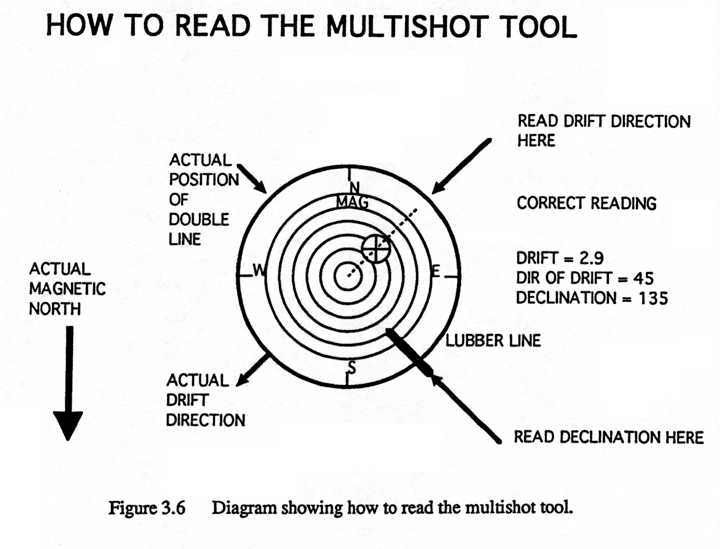
Downhole logging using magnetometers and susceptibility tools can provide
high-resolution data useful for understanding the magnetic properties of
oceanic crustal sections. Magnetic logging in basement holes has been shown
to be able to indicate magnetic polarity units, flow morphology and
boundaries, and alteration zones, especially when interpreted along with
magnetic studies of core samples and standard geophysical logs (for examples
of magnetic logging results, see Bosum and Scott, 1988; Pariso et al., 1991;
Figs. 3.8 - 3.10).
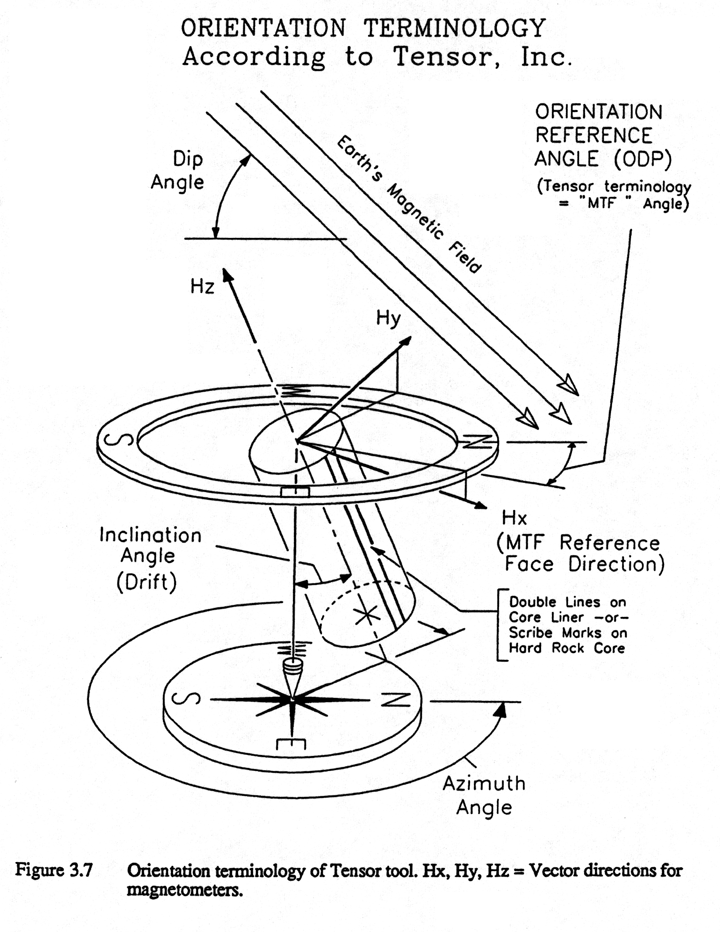
Several organizations have produced and run downhole magnetometers and
susceptibility tools on the JOIDES Resolution. An excellent summary of the
tools used on and prior to Leg 118 is provided in the Site 735" chapter of
the Initial Reports for that leg (Robinson, Von Herzen, et al., 1989). These
include the following: a three-axis magnetometer produced by the
Bundesanstalt für Geowissenschaften und Rohstoffe (BGR) (initial ODP run on
Leg 102); a U.S. Geological Survey magnetic-susceptibility tool (first ODP
run on Leg 102); a Japanese self-contained high-temperature three-axis
borehole magnetometer (first ODP run on Leg 109; later version run on Legs
143 and 144); a three-component magnetometer in the Schlumberger General
Purpose Inclinometer Capsule (GPIC), run in conjunction with Schlumberger's
Lithodensity Tool (LDT) and used as part of the standard Schlumberger
geophysical tool suite on several legs; and an experimental three-coil
magnetic-susceptibility probe produced by the Institute of Applied Geophysics
at the University of Washington. On Leg 134, shipboard paleomagnetists
successfully tested a magnetic-susceptibility tool and a total-field
magnetometer produced by LETI-CEA and Total-CFP, France, in sediments (the
results are presented in Figure 3.11). Information about the tools and their
results can be found in the Proceedings volumes pertaining to the legs on
which the tools were run.
